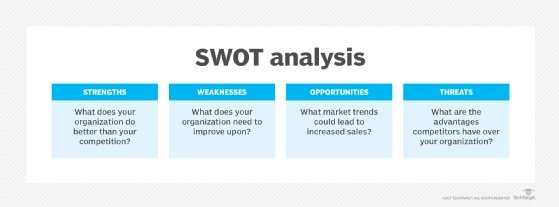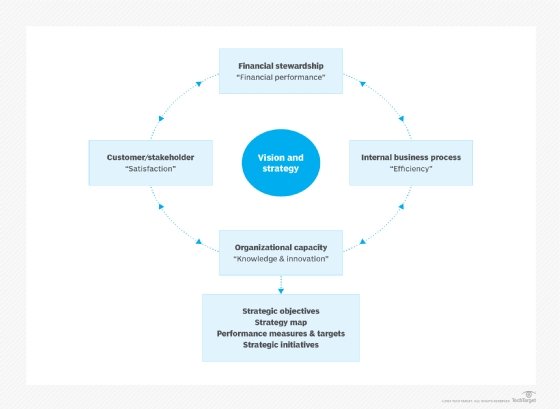
strategic management
What is strategic management?
Strategic management is the ongoing planning, monitoring, analysis and assessment of the resources and processes an organization should have in place to meet its goals and objectives. Because business environments are dynamic, an organization must constantly assess its strategies to stay competitive and meet its long-term objectives.
The strategic management process helps organizations consider their present situation, develop action plans, deploy those plans and analyze their effectiveness. The process typically includes five basic stages, but the goals and outcomes can vary significantly depending on an organization's goals as well as its internal and external environments.
Strategic management enables an organization to have a clear understanding of its mission, its vision for where it wants to be in the future and the values that will guide its actions. The process requires a commitment to strategic planning, which is a subset of business management that requires an organization to identify its short- and long-term goals. Strategic planning also includes the planning of the processes and resources needed to achieve those goals.
Having a defined process for managing an organization's strategies can help leadership make better decisions and develop new goals quickly to keep pace with evolving technology, market and business conditions. Strategic management can help an organization gain competitive advantage, improve its market share and plan for the future.
This article is part of
The evolving CIO role: From IT operator to business strategist
What are the benefits of strategic management?
Strategic management offers financial and nonfinancial benefits. It helps an organization's leadership better plan for the future and meet its long-term objectives. Strategic management also provides additional benefits:
- Clear direction. Strategic management sets a direction for the organization and its personnel. It clarifies the organization's mission and vision and helps it reach its goals. Resources and operations are prioritized based on those goals and planned with an eye toward the organization's long-term objectives.
- Operational improvement. Strategic management helps to define a clear purpose and direction. The organization's efforts are more cohesive because everyone is focused on the same objectives, with successes tracked and carefully measured. Strategic management also incorporates an objective review of internal operations, resulting in greater efficiency.
- Resource optimization. With strategic management, resources of all types are better planned and managed, resulting in more efficient resource utilization. Resource usage is also prioritized based on stated objectives and goals.
- Competitive advantage. The ongoing analysis of external forces makes it possible to respond to competitive threats more quickly and efficiently as well as capitalize on potential opportunities. The organization becomes more proactive in carrying out business, potentially increasing its market share and profitability. Ongoing analysis also helps the organization differentiate itself more clearly from its competitors.
- Sustainable growth. Strategic management requires the ongoing analysis of internal and external forces. The analysis includes a wide range of factors, from social to environmental to the competitive landscape. This process can help mitigate risks and make it easier to adapt to market changes, while improving the overall decision-making process.
Unlike once-and-done strategic plans, effective strategic management requires continuous planning, monitoring and testing of an organization's processes and resource utilization.
What are the 5 steps in the strategic management process?
There are many schools of thought on how to implement strategic management. Academics and managers have developed numerous frameworks to guide the strategic management process. Despite the differences, the process typically includes five stages:
- Identify direction. Assess the organization's current strategic direction. Identify its mission and long-term vision along with its objectives and goals. Leadership should be able to clearly articulate what the organization is trying to achieve.
- Analyze environment. Identify and analyze factors in the internal and external environments. Use tools such as SWOT analysis to examine the strengths, weaknesses, opportunities and threats in those environments.
- Develop strategy. Formulate an action plan that defines how the organization will reach its goals and the resources to get there, considering what was learned from the analysis stage. Also establish performance metrics that measure success.
- Execute strategy. Put the plan into action using the resources defined in the previous step. Strong leadership and clear communication are essential. Each phase of the plan's execution should be carefully monitored, with issues addressed as they arise.
- Evaluate implementation. Continuously assess various aspects of the plan to determine how successful each one has been using the performance metrics identified in the development stage. Adjust the strategy if the desired results have not been achieved.
Effective communication, data collection and organizational culture also play important roles in the strategic management process, especially at large, complex organizations. Lack of communication and a negative corporate culture can result in a misalignment of the organization's strategic management plan and the activities undertaken by its various business units and departments. Leadership should also assess cross-functional business decisions prior to implementing them to ensure they are aligned with strategic plans.
SWOT analysis
A SWOT analysis is a method organizations use to evaluate internal and external environments when planning their business strategies. The analysis identifies and examines the strengths and weaknesses of the organization's internal environment as well as the opportunities and threats in the external environment.
The analysis examines and compares the internal strengths and weaknesses to the external opportunities and threats. It also identifies internal and external factors that can impact the organization's goals and objectives.
The SWOT process helps leadership determine whether the organization's resources and strategies will be effective in the competitive environment. It also helps to refine the strategies required to remain successful in this environment. By performing a SWOT analysis, an organization will can implement a strategic management plan that considers both internal and external factors that can influence the overall strategy.

Balanced scorecard in strategic management
The balanced scorecard is a management technique that turns strategic goals into a set of performance objectives that can be measured, monitored and changed, if necessary, to ensure the strategic goals are met. The balanced scorecard takes a four-pronged approach to an organization's performance:
- It incorporates traditional financial analyses that include metrics such as operating income, sales growth and return on investment.
- It performs a customer analysis that considers customer satisfaction and retention.
- It carries out an internal analysis that includes how business processes are linked to strategic goals.
- It performs a learning and growth analysis that includes employee satisfaction and retention, as well as the performance of the organization's information services.
This is further explained by the Balanced Scorecard Institute.
The system connects the dots between big picture strategy elements such as mission (our purpose), vision (what we aspire for), core values (what we believe in), strategic focus areas (themes, results and/or goals) and the more operational elements such as objectives (continuous improvement activities), measures (or key performance indicators, or KPIs, which track strategic performance), targets (our desired level of performance), and initiatives (projects that help you reach your targets).

Value of organizational culture
Organizational culture can determine the success or failure of a business and is a key component that strategic leaders must consider in strategic management. Culture is a major factor in the way people in an organization outline objectives, execute tasks and organize resources.
A strong organizational culture can make it easier for leaders and managers to motivate employees to carry out their tasks in alignment with the outlined strategies. At organizations where lower-level managers and employees are expected to be involved in decision-making and strategic planning, the strategic management process should facilitate their participation.
It is important to create strategies that are suitable to the organization's culture. If a particular strategy does not match that culture, it will hinder the organization's ability to accomplish the strategy's intended outcomes.
The evolution of strategic management
Approaches to strategic management have evolved over time. The modern discipline of strategic management traces its roots to the 1950s and 1960s. Prominent thinkers in the field include Peter Drucker, sometimes referred to as the founding father of management studies. Among his contributions was the seminal idea that the purpose of a business is to create a customer, and what the customer wants determines what a business is. Management's main job is marshalling the resources and helping employees efficiently address customers' evolving needs and preferences.
A brief explanation of how to be a collaborative and strategic leader in the information age.
Distinctive competence, a term introduced in 1957 by sociology and law scholar Philip Selznick, focused on the idea of core competencies and competitive advantage in strategic management theory. This enabled the creation of frameworks for assessing the strengths and weaknesses of an organization in relation to the threats and opportunities in its external environment.
In the 1980s, Theodore Levitt, a Harvard Business School professor, developed a strategy that, like Drucker's theory, also focused on the customer. This strategy was a departure from many other theories at the time, which emphasized production as the primary motivator.
Canadian management scientist Henry Mintzberg concluded that the strategic management process is often more dynamic and less predictable than management theorists had thought. In his 1987 paper, "The Strategy Concept I: Five Ps for Strategy," he argued "the field of strategic management cannot afford to rely on a single definition of strategy." Instead, he outlined five definitions of strategy and their interrelationships:
- Plan. Strategy as a consciously intended course of action to deal with a situation.
- Ploy. Strategy as a maneuver to outwit a competitor, which can be part of a defined plan.
- Pattern. Strategy stemming from consistent or successful behavior whether or not it is intended or part of a plan.
- Position. Strategy as a mediating force or match between the organization and environment. It can be compatible with any or all the other Ps.
- Perspective. Strategy as a concept or ingrained way of perceiving the world (e.g., aggressive pacesetter vs. late mover). It can be compatible with any or all the other definitions.
Following this step-by-step guide to learn how to assess an organization's needs and implement a technology strategy that delivers.






